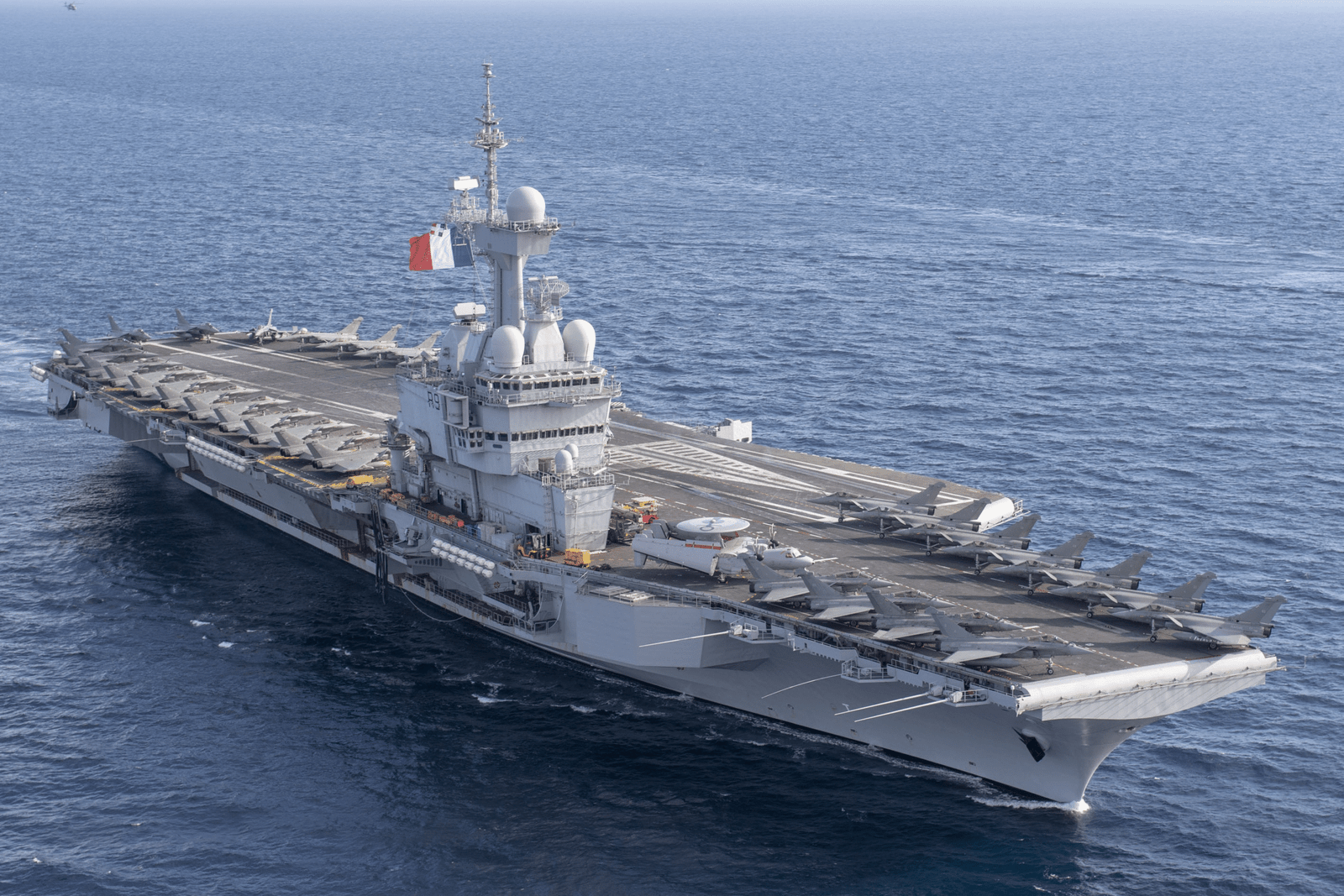
Aircraft carriers have been a central factor for nearly a hundred years in determining who controls the seas. In essence, these ironclads that roam the ocean are just mobile airbases. Thanks to them, countries can impose their authority, discourage the rivalry, and extend their operational zone far beyond their coastal areas. At present, they are not only the emblems of national pride, but they also represent the powerful strategic weapons that can decide war conflicts and balance global military forces. Here are ten of the world’s largest and most powerful aircraft carriers, which are the most advanced masterpieces of contemporary naval engineering.

10. Charles de Gaulle
The French nuclear-powered aircraft carrier Charles de Gaulle is the only one outside the United States. 42,500 tonnes and 261 meters long, its maximum takeoff capacity is 40 aerial vehicles. Among them are the Rafale M fighter and the E-2C Hawkeye early warning planes. It is an ideal ship for long-term missions due to the nearly unlimited cruising range provided by its nuclear reactors. Charles de Gaulle has been very active in French military operations throughout the Mediterranean, the Middle East, and more. It is planned to replace it with the bigger and more advanced PA-NG with updated launching systems.

9. INS Vikrant
INS Vikrant of India is a milestone in local shipbuilding. Weighing about 45,000 tonnes and 262 meters long, it is capable of carrying around 40 aircraft, including MiG-29K fighters and helicopters. Its ski-jump deck is designed for STOBAR operations, and the carrier is also equipped with advanced radar and defensive systems. By its commissioning, India has made it clear that it has the potential to exert naval dominance over the Indian Ocean.

8. INS Vikramaditya
INS Vikramaditya was originally the Soviet Admiral Gorshkov, retired and inducted into Indian service. At 45,400 tonnes and 283.5 meters long, it can take up to 36 aircraft, primarily the MiG-29K. In fact, it allows India to have a true blue-water navy capability along with Vikrant, giving the fleet the ability to exert power far away from their own waters both in times of peace and war.

7. Liaoning
Liaoning, a Kuz,netsov-class carrier, was rehabilitated and put into service in 2012. It has a displacement of around 58,000 tonnes and is 304 meters long with a complement of up to 50 aircraft. While it is primarily a training carrier for pilots, it is also a fully combat-ready carrier. Its arrival has changed carrier operational procedures, facilitated easier flight deck operations, and prepared the way for more advanced designs.

6. Admiral Kuznetsov
Admiral Kuznetsov, the only Russian aircraft carrier that is currently in service, is the flagship of the Russian Navy. At 305 meters and 58,500 tonnes, the modifications made allowed for 33 fixed-wing aircraft and about a dozen helicopters to be carried. The ship represents Russia’s commitment to carrier-based aviation, despite numerous repair issues, as it combines the conventional use of aircraft with the installation of heavy missile systems.

5. Queen Elizabeth Class
HMS Queen Elizabeth and HMS Prince of Wales, the two biggest warships in t, he history of the UK, are the crown jewels of the Royal Navy. Both ships are of about 65,000 tonnes and 280 meters and can accommodate, ate up to 40 aircraft, including F-35B jets and Merlin helicopters. The installation of the ski-jump decks makes it possible to carry out STOVL operations, and the high automation levels keep small crews working efficiently. These carriers make up most of Britain’s naval power and allow her global reach.

4. Shandong
Established in 2019, Shandong is a carrier designed and constructed entirely within China as the first of its class. Its displacement is approximately 70,000 tonnes, and it measures 305 meters long with a complement of 44 aircraft. Despite still utilizing a ski-jump launching mechanism, it has received several improvements, such as upgraded facilities, modern systems, and enhanced operational support that represent r breakthrough in carrier development.

3. Fujian
The spectacular Fujian unconventional carrier with electromagnetic catapults is 2022 launched rather than the traditional ski-jump. This giant measuring 316 meters long and weighing 80,00aonnes can handle a greater number of larger aircraft to make flight operations flexible and bring it closer to parity with the world’s most powerful carriers.

2. Nimitz Class
Since the States’s the United States’ Nimitz-class carriers have been the bulwark of American naval power. Each of them, having a mass of 97,000 tonnes and a length of 332.8 meters, can take more than 60 aircraft. The installation of two nuclear reactors endows them with almost infinite endurance and a range that is unrivaled in practice. Nimitz carriers have been at the forefront of U.S. naval missions in all major wars during he last forty years; thus, the hallmark of carrier-based power projection has been set.

1. Gerald R. Ford Class
The Gerald R. Ford class is the zenith of carrier design. The flagship, USS Gerald R. Ford, weighs 100,000 tonnes and is 337 meters long, with a complement of over 75 aircraft. The application of advanced systems such as EMALS catapults and the Advanced Arresting Gear has brought about the development of flight operations, efficiency, and safety. Automation has been instrumental in completing various tasks that would otherwise require larger crew numbers, thus raising the survivability and combat rpresent-dayvels. The present-day carrier warfare receives its defining features from this class.

The Future of Carrier Power
The competition for carrier supremacy is not about to fade away. More countries are eager to refine and enlarge their fleets by bringing in the latest technology and design advances. The existing carriers are at the center of strategic planning; these gigantic, very sophisticated ships are necessary instruments for power projection at sea. For many years to follow, aircraft carriers will remain the à la mo, de in naval strategy, combining innovation, endurance, and firepower.
